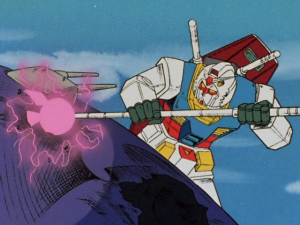|
|
|
Mobile Suit Gundam (DVD), Review
By Logan | July 21st, 2013
 As one of the most well-known mecha series in the world, Mobile Suit Gundam is the genesis of a franchise that is still going more than 30 years later, and with countless sequels, spin-offs, manga, video games, and of course plastic model kits, Yoshiyuki Tomino’s epic is credited with cementing the “Real Robot” genre into its place in anime history. After the rousing success of Mobile Suit Gundam Wing on Cartoon Network’s infamous and recently resurrected Toonami block, the original 1979 series that started it all made its way to American shores. A decade later, Bandai Entertainment gave fans in America the most complete version of the series it could possibly provide us; but is it worth it to track down these sets, now that Bandai is no longer with us? In the summer of 2001, Mobile Suit Gundam premiered on Toonami and shortly after, saw the release of the first DVDs, which were a plain affair featuring a dub-only audio track and a lack of special features. In the wake of the September 11th attacks, coupled with less-than-stellar ratings, the series was pulled from the Toonami lineup, though the DVDs continued into June 2002, but as a result of the US getting the series on DVD before Japan, Bandai Entertainment was not allowed to use the original Japanese audio track, nor would Episode 15 be included, as ordered by series creator Tomino. Finally, after the first 3 DVDs were released, Bandai was forced to change to a new opening sequence, resulting in the same intro used on Toonami being used for most of the series.
This 10-disc release would be the sole version available in the US for almost a decade, while in 2007, Japanese fans finally received a DVD release which included newly remastered footage of all 43 original episodes produced from HD scans of the original film, spread across 12 volumes. Eventually, in 2010, Bandai Entertainment announced they would be re-releasing Mobile Suit Gundam in the US as a part of their Anime Legends budget line, and would be including the original Japanese audio and subtitles for the first time. Fans questioned if this was the sign they had been waiting for; the sign that Bandai was turning the Gundam franchise around after years of issues, and after a considerable wait, Bandai finally released the first half of the series in a 4-disc set in September of 2011, following up with the second set in February 2012. That release ended up as one of Bandai Entertainment’s final new releases in the US as unfortunately, not long after, fans found they would no longer hear the cries of “It’s a Gundam!” as Bandai would be shutting down operations in North America. With the history lesson over, we’ll start with a look at the packaging, where both sets feature Scanavo single-size DVD cases with overlapping discs on both sides, something not unexpected for the budget Anime Legends label. The artwork for each set is themed for the two opposing sides in the series, with Collection 1 representing the Earth Federation, featuring a painting of the Gundam and its pilot Amuro Ray, bordered by a silver and white frame, and a silver “Anime Legends” banner at the top, while Collection 2 shows its allegiance to Zeon with a trio of Zaku mobile suits in a red Zeon themed frame, with the same Anime Legends banner at the top. The back of the cases each feature a block of text, with two paragraphs dedicated to explaining the events of the series contained in each set, with a list of the episodes and what discs they are found on, followed by a selection of images from the various episodes just below. A list of DVD features, staff credits, and a data grid of technical specs, coupled with logos for the various companies involved, takes up the bottom third of the back cover, where the faction color theme is continued as well. The disc art uses eight of the covers from the original 10-volume DVD release, but neither set includes any sort of insert, unlike the original 2001 release, which included inserts that featured definitions of terms, locations, and other various information. However, with the ease of access to these same things online, this is hardly worth considering a loss. Moving on to the menus, they are very basic, but functional, with the main menu of each disc using the same picture used for the disc art, while the various sub-menus feature images from episodes or production artwork as the backgrounds. Extras include a quick skip to the English-translated production credits, trailers for various Bandai shows and movies, and credits for the DVD authoring. Humorously, Disc 3 includes a trailer advertising a 2011 release of Turn A Gundam, which never ended up seeing the light of day after Bandai announced their discontinuation of new title releases in January 2012. It’s also worth mentioning that a few menu pages have visual oddities on the artwork, suggesting it was improperly resized. The story of Mobile Suit Gundam is easily recognized by anyone familiar with the Gundam franchise, as of course this is where it all started, with the plot often copied with some alterations, most notably in Mobile Suit Gundam SEED, which uses much of the same pacing and story progression. The story begins nearly 80 years into the “Universal Century”, where much of humanity lives in giant space colonies orbiting the Earth. The colonies furthest from the Earth declared independence as the Principality of Zeon and are waging a war with the Earth Federation in which the dropping of colonies onto the Earth and nuclear attacks on the Zeon colonies has resulted in over half the population of both sides perishing. Zeon’s strength lies in their use of mobile suits, giant humanoid weapons, of which the Federation has no equal. After 8 months of fighting, the war, which would eventually come to be known as the “One Year War”, was at a stalemate.
The first episode begins on the peaceful colony of Side 7, where we are quickly introduced to Amuro Ray, an engineering student; Char Aznable, one of Zeon’s top pilots; and Bright Noa, a young officer in the Federation Forces, along with various Federation officers and citizens of the colony that make up the main cast. It is here that Amuro joins the crew of the Assault Carrier White Base and becomes the pilot of the Gundam, the Federation’s answer to Zeon’s mobile suits, designed by Amuro’s father. The story follows the White Base and its crew as they begin to turn the war in favor of the Federation with the help of the Gundam, coupled with Amuro’s awakening powers as a “Newtype” — a sort of ‘next step’ in human evolution thanks to the migration to outer space. The first half of the series mostly focuses on the journey of the White Base as it leaves Side 7 with the Gundam and the other suits developed as part of the V Project. White Base travels back to Earth, at which point it makes its way across the planet to Jaburo, the Earth Federation’s underground headquarters in South America. As they cross the globe, White Base is assisted by Matilda, a member of the Federation Supply Corps — on orders from General Revil, who is known for being the head of the V Project, which resulted in the Gundam, Guncannon, and Guntank. Still under assault from the Zeon Forces led by Char, White Base arrives in Jaburo and is quickly activated as part of the Earth Federation Space Forces, returning them to the front lines of space, aided by Sleggar Law — charismatic pilot of the G-Fighter. At the same time, Char has taken a young Newtype, Lalah Sune, under his wing to further develop her abilities, even while his own grow stronger as the war rages on. Like Char, Amuro finds himself drawn to her as well, creating a strong rivalry between the two, which carries into their later appearances.
In the final hours of the war, the Zeon Forces are pushed back to their last line of defense: the space fortress A Baoa Qu, where Amuro and Char face off one last time as the war draws to a close. The series ends with the Earth Federation as the victors, setting the stage for the eventual sequel series — Mobile Suit Zeta Gundam — and the various OVAs that take place both during and shortly after the One Year War. The major differences with Mobile Suit Gundam compared to other mecha series of the era are clear from the start, such as forgoing flashy powers and grandiose designs, along with relying on an ancient evil power or invading alien army as the villain. Instead, the robots are military hardware used as tools of war in a human struggle for independence. Admittedly, the show does fall into a sort of “monster-of-the-week” formula toward the end with one-off pilots and some very silly mobile armor designs, something the later compilation movies corrected by all but eliminating them, but the overall pacing is solid.
Mobile Suit Gundam is often compared to Star Trek, due in part to neither show garnering very successful ratings during their original run, with the series shortened to a run of 39 episodes, which the staff negotiated extending to a final count of 43 episodes in order to give it a proper wrap-up. Later, after Bandai’s hobby division began to produce model kits of the mobile suits, the show’s popularity exploded and resulted in a trilogy of theatrical adaptations being produced, which were followed by the sequel Zeta Gundam in 1985. In terms of video quality, these sets offer the best fans could ask for by using the 2007 masters created for the Japanese DVD release, although this was never advertised. As someone who owns the Japanese DVDs, I was very pleased to see that despite a reduction in the number of discs — the Japanese release was spread over 12 discs, while the Anime Legends set is only 8 discs — the picture quality is still excellent, though it is worth mentioning that the opening and ending appear to be a bit “softer” than their sharper Japanese counterparts, but that isn’t enough to take away from the overall quality. This new release also keeps the Japanese credits through the entire series, as well as the original episode title cards and eyecatches. After the episodes play through, a silent clip is played with English translations credits scrolling by on a black frame, similar to other Bandai Gundam DVD releases like Mobile Fighter G Gundam and Gundam SEED. Regarding audio, two tracks are offered, English 2.0 Dolby Stereo and Japanese mono, both encoded at 224kbps AC3. In terms of the dub, it is worth noting that unlike the Japanese track, which retains the classic sound effects used in most Gundam productions, the dub uses different effects for elements such as beam sabers and weapons fire. Beyond this, there are some other issues with the dub presentation, including mono encoding on the first disc, and a noticeable audio sync issue through the first set. Thankfully, the issue disappears as the show reaches its mid-point, but it is disappointing the issue exists at all, even if it is an understandable result of using the old dub audio with the remastered footage. Overall, outside of the encoding issues on the first disc, the dub is crisp, and while the Japanese audio sounds a bit muddier, it’s understandable given the age of the track.
With extras, other than trailers for other Bandai shows, the features offered on these sets are nearly non-existent; however, the repeated lack of the original Episode 15 — “Cucuruz Doan’s Island” — is disappointing, and would have provided a nice extra to have subtitled, seeing as it wasn’t dubbed. Having actually seen the episode, there’s nothing particularly special about it outside of some questionable animation, but its continued exclusion makes the American Gundam sets feel incomplete. Despite it being 34 years old, Mobile Suit Gundam still holds up as a fairly solid series, and while many fans prefer the easier to digest narratives of the compilations, there is a certain charm to the original series itself. It also provides an interesting look back to see where the tropes of not only the Gundam franchise, but the genre as a whole, came to be. Each set was originally available for about $30 or less, and at that kind of price, it would be hard to not recommend it to any fan of Gundam or mecha in general. For anyone who already owns the previous dub-only release, these sets are a huge upgrade over the previous version and certainly worth the money thanks to the upgrade in the video quality. As of this review, unfortunately, Amazon prices for the two parts are $90 and $175, and as always, eBay is rife with bootlegs with massively inferior picture and audio quality. With Sunrise still in discussions with Funimation and Sentai about getting the Bandai Entertainment catalog back in production, fans should watch for news on that front and hope for a re-release from one of those companies to result in something that is once again affordable. But, if you can find these sets even for $50-60, I would suggest snatching them up because they really are worth it.
Show: A- (A fun show that’s mostly well-paced, with a few slow spots during the final third.) Overall (not an average): A (As the origin of the entire Gundam franchise, this one deserves to be called a classic. It’s not the prettiest animation, but it’s still a fun, action-packed series with quality character growth.)
A full gallery is provided under the ad. All caps are lossless PNGs taken in MPC-HC, feel free to request more. (Caps are sized 640×480 so as to display properly on computer monitors, they were modified to this resolution via Photoshop CS6 as MPC-HC takes screen captures at 720×480 on the disc. Having the caps altered to 640×480 makes them appear at the properly intended aspect ratio.) This show was reviewed using retail copies purchased at Amazon.com This DVD is labeled to work in Region 1.
|
Recent Posts
Archives
Categories
Advertisement
|











































